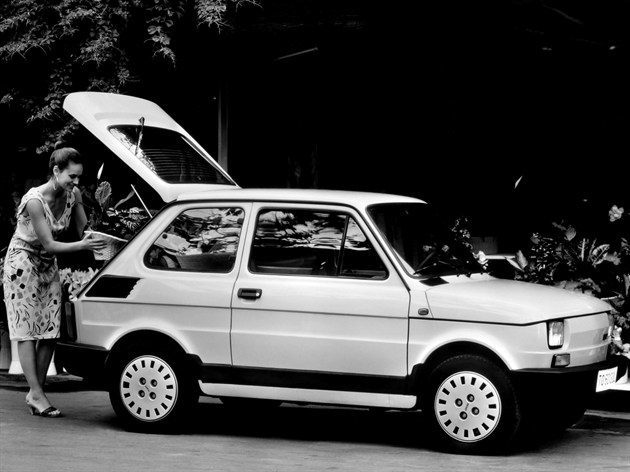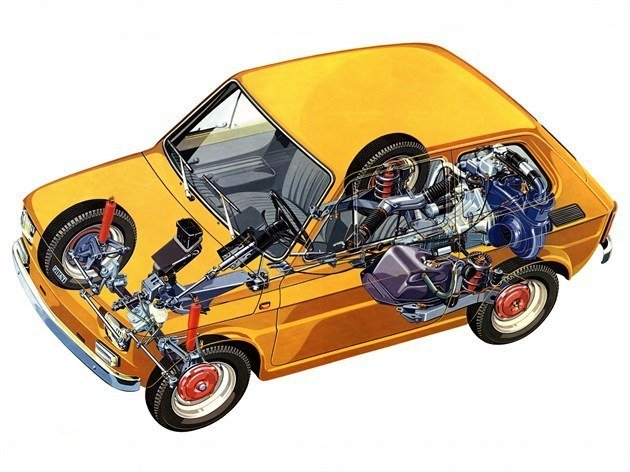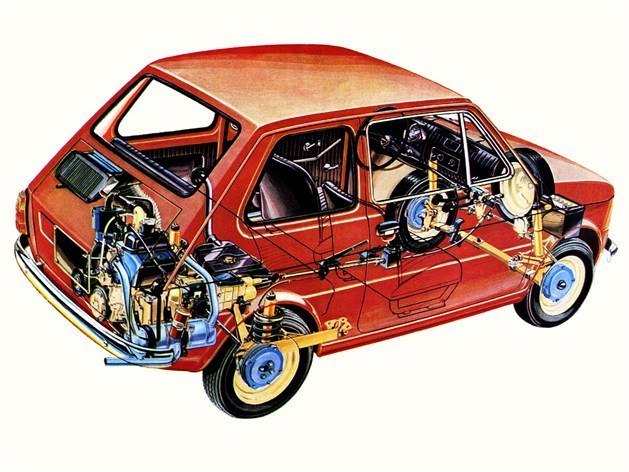- Reviews
- Ask HJ
- How Many Survived
- Classic Cars For Sale
- Insurance
- Profile
- Log out
- Log in
- New account
Fiat 126 (1972 – 1987) Review
Fiat 126 (1972 – 1987) At A Glance



The Fiat 126 had a tough gig, replacing the Nuova 500. But in reality, it did quite well considering it was almost a lone rear-engined challenger in a market sector increasingly affluent Europeans were turning their back on by the early-1970s. It continued the appealing boxy styling established by the 127 (and was also used in the SEAT 133), and looked up to the minute - even if it didn't drive that way.
The air-cooled two-cylinder engine stubbornly remained slung out to the rear, despite Fiat’s move to FWD elsewhere in the range, and performance was leisurely in the extreme. But it’s cheap as chips to run today, and thanks to a long production run in Italy and then Poland, there’s still a plentiful supply of cars and parts - especially from Eastern Europe. Replaced by the radically upgraded, hatchbacked, but similar looking 126bis
Model History
- January 0001: 1968: Fiat starts work on what becomes the 126
- January 0001: 1972: Fiat 126 launched
- January 0001: 1973: Fiat production begins in 1973 in Poland
- January 0001: 1976: Engine uprated
- January 0001: 1987: 126BIS launched
January 0001
1968: Fiat starts work on what becomes the 126
In the late Sixties, Fiat was in a dilemma regarding its future small car strategy. Front wheel drive looked like the future – and the introduction of the 127 and 128 proved the format worked well, with few downsides. However, there was still a healthy demand for its budget baby cars typified by the 500 and 600D.
The new generation cars were appreciably more expensive than the rear engined baby cars, and that meant in order not to lose its customers, Fiat would need to remain in that market sector. Producing a new front wheel drive baby-car cast in the Seventies mould would be expensive, and a commercial risk, so instead, the company decided to take the 500’s mechanical underpinnings and clothe it in a contemporary looking body.
January 0001
1972: Fiat 126 launched
So, when it emerged in 1972, the Fiat 126 looked like a scaled down version of its clever big brother. But underneath, it used the familiar aircooled 594cc two-cylinder engine that had done sterling service in previous baby Fiats. With less than 30bhp to call on, it maintained its predecessor’s legendary lack of performance – but managed to lose a fair bit of its charm in the process.
Initial press reports were reasonably positive, but as the decade wore on, popularity in export markets waned as bigger superminis became the hot motoring ticket, and increasingly affluent customers eschewed the delights of the twin-cylinder Fiat.
January 0001
1973: Fiat production begins in 1973 in Poland
The 126 made an appearance on the UK price lists in 1973, after debuting at the Turin Motor Show the previous October. From there, the 126’s equipment tally gained a number of additions through the years (such as the full-length fabric sunroof)
Throughout its life, the 126 fought with various East European imports for the title of the cheapest car available in the UK – and with the Citroen 2CV as the slowest. Out in the margins of Fiat the range, assembly of the 126 began in Poland at the FSM factory in 1973, and by 1980, it was the sole factory building these cars.
January 0001
1976: Engine uprated
Engine capacity was raised to 652cc, and a new top-of-the range De Ville variation was rolled out.
January 0001
1987: 126BIS launched
Engine capacity increased once again to 704cc in the much improved 126 Bis (below) in 1987. This was a most radical upgrade, with a new horizontal water-cooled engine and hatchback rear end. This makes this the 126 of choice – and plenty are still in daily use in Poland…

Fiat 126 (1972 – 1987) Buying Guide
Good
- Small
- Cheap
- Fun in a masochistic way
- Parts remain reasonably easy to find – and don’t discount the idea of visiting your local main dealer (assuming you get the right ‘parts’ man who won’t laugh at you).
- Many servicing consumables are still readily available off the shelf from your local factors, too.
Bad
- Slow
- Uncomfortable
- Is it too small for modern roads?
- There aren’t any 126 specialists, but a number of firms that concentrate on Italian cars consider the car to be one of their own.

Watch
- Body corrosion: Like all Fiats of this vintage, the 126 suffers from corrosion.
- You can look anywhere for rust, and the main areas of concern are the sills, floorpans, inner wings, wheelarches and front outer wings. The good news is that many panels are still readily available new, and are very reasonably priced indeed.
- Front wings aren't generally too bad but can go under the rubber seal on top that mates with the boot lid. And if you do need to buy replacement front wings be aware that wings on the Polish built cars are one of the few components that won't also fit cars made in Italy
- Electrics: Although Fiats of this vintage have a reputation for flaky electrics, the 126 doesn’t suffer too badly from major problems – on account of the fact that there are very few electrical components to stop working!
- The main issues are poor connections, and corroded earths, which lead to all sorts of random failures. Make sure these are in good order, and keep them that way (i.e., make sure you keep everything dry), and you’ll be fine
- Engines: Okay, let’s not beat around the bush here – 126s don’t do high mileages, and the engines have been built with that in mind.
- The best maintained examples will soldier on to 100,000 miles, whereas id you skip the odd service now and then, expect that figure to drop to 60,000.
- Rattles can be missed, so listen carefully, and the extensive use of alloy inside also causes problems.
- Aircooled engines need to be checked for the condition of their tinware, and run surprisingly hot before they pack up.
- Water cooled cars, but most experts agree that discarding the thermostat is a guaranteed way of enjoying a quiet life.
- Gearbox: These can fail on low mileage cars if the plastic oil seal fails where the driveshaft enters the transmission. You’ll struggle to find good secondhand gearboxes for replacement as many have gone on to lead second lives under the deck lids of 500s.
- Check the condition of driveshaft seals, and look for oil leaks – both can have catastrophic effects.
- Interior: Trim and interior components are still readily available from Eastern Europe – and cheap build quality means that you’ll already be searching the Internet for bits and pieces.
- Suspension: Don’t worry if there’s play in the wheelbearings, as this is a designed-in feature – and other than that, there are few nasties to worry about.
- Front leaf springs are lightly loaded and rarely pack up, while the rear trailing arms can suffer from corrosion in extreme cases.
- Steering: Italian cars came with a decent steering box, but the Polish ones are much nicer, having a rack and pinion set-up. In both cases, you’ll have little to worry about.

Running Fiat 126 (1972 – 1987)
Contacts:
- Middle Barton Garage 55 North Street, Middle Barton, Oxforshire, OX7 7BH, +44 (0)1869 340289, www.racecar.co.uk/mbg/homeset.htm
- Auto Rossa (International), 3 Hightown Industrial Estate, Crow Arch Lane, Ringwood, Hampshire BH24 1ND, www.autorossa.com/index.htm
- Web based Fiat 126 Club: www.fiat126.co.uk/
- Fiat Motor Club GB, 01458 250116, www.fiatmotorclubgb.com/
- Every Car Part Classics, www.everycarpart.co.uk/classic/index.php/cPath/59_61
- Fancy Engineering, www.fancyengineering.co.uk, Dorchester +44 (0)1300 345577
- Seven Day Auto Spares, 96-98 Coventry Street Digbeth , Birmingham, B5 5NY
- Tel: +44 (0)121-643-5559

.jpg?width=640&height=426&rmode=crop)
.jpg?width=640&height=426&rmode=crop)